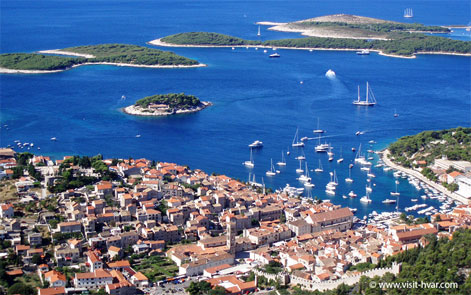
The Dalmatian Coast is said to be one of the most beautiful coastline in Europe. Dotted along the Croatian coast are islands, each has its different shape and size and offers its own attraction and beauty. Hvar Island (pronounced phwoar) along with the rest of the Dalmatian Coast has grown into a must visit European destination. It was overlooked for the only Greek islands and its westerly neighbours the Italians. Known as the Croatian Madeira, Hvar receives 300 days of sunshine each year - making it the sunniest spot in the Adriatic both in summer and winter.
An approach to the island it looks like those pictures you see in the brochures. Overlooking the bay is a cluster of terracotta-roofed houses overlooking its beautiful natural harbour. The smell of Lavender sold on every stall along the waterfront gives it a beautiful welcome smell. The port is dominated by one of the largest squares in Dalmatia (over 48,000 square feet), surrounded by quaint cafes, sophisticated bars and the impressive facades of some of Europe’s finest hotels.
Despites its growing popularity Hvar has manage to maintain some of its old charm. Its small polish cobbled street and fine stone-carving which adorn the buildings, are remnants of it glory days as part of the Venetian Empire. Archaeological finds from Markova and Grapceva have identified the origins of Hvar culture to as early as 2500BC.
The town of Hvar is an extremely attractive place, with its cathedral, bishop’s palace, Franciscan monastery and lovely old houses and churches, and the view from the Spanjol fortress is breath taking. Stari Grand is well worth visiting for its Dominican monastery and the fortified Trvdalj summer residence of the poet Hektorovic. Slip into the picturesque and charming little town of Vrboska.
Hvar Island is one of the sort after destination among Europeans. Its piazza and alleyways lined with chic boutiques, cafes and seafood restaurants; the intense, clear blue waters to one side, and pine-covered slopes behind, shows why many flock here each year. With a mixture of chic hotels, family homes and guesthouses, Hvar is a milting pot of people; you find the simple, aristocrats and backpackers all melding. Even with its growing popularity and it party atmosphere it is not like Ibiza.
Far a seaside destination Hvar does not offer sandy beaches compare to tropical destinations but what lack of in one area it make up for in others, you can hire a small boat and find your own pebble cove. The nearest thing to a beach is on the outlying islets Pakleni Otoci, a pine-forested archipelago buffering the town’s harbour. The best spot is on Parmizana, it offers a sandy stretch of flanked by restaurants.
Hvar standout for its food, especially by the main piazza; there a hosts of bars and eateries, serving the ubiquitous pasta and pizza and Dalmatian delicacies such as octopus salad, boiled langoustines, brodetto fish stew, black risotto and lobster pasta.
August, Hvar is at it liveliest when its clubs and cafes are buzzing; the low keyed time is September when the water is still warm but there are less visitors.